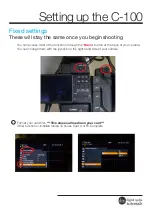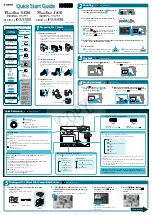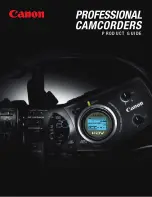
These operating instructions are a publication by Conrad Electronic SE, Klaus-Conrad-Str. 1,
D-92240 Hirschau (www.conrad.com).
All rights including translation reserved. Reproduction by any method, e.g. photocopy, microfilming,
or the capture in electronic data processing systems require the prior written approval by the editor.
Reprinting, also in part, is prohibited.
These operating instructions represent the technical status at the time of printing. Changes in
technology and equipment reserved.
© Copyright 2013 by Conrad Electronic SE.
Disposal
Electronic devices are recyclable waste materials and must not be disposed of in the
household waste!
Dispose of the unserviceable product according to the relevant statutory regulations!
Technical Data
Sensor .........................................1/3” (8,47 mm) CCP with 512 x 582 pixels
Video system: ..............................PAL
Video signal .................................1V/pp / 75 Ohm
Operating voltage ........................12Vdc
Operating current .........................approx. 180 mA
Operating temperature ................-20°C to +70°C and max. 95% rel. air humidity
Lighting ........................................4 Infrared LEDs
Viewing angle ..............................approx. 110°
Coverage: ....................................max. 3 m
Dimensions (L x W x H) ...............approx. 522 x 137 x 38 mm
Mounting the number plate camera.
m
The number plate camera is designed for installation on the rear of the vehicle. If it is
installed on the front of the vehicle, damage from stone strikes cannot be excluded.
The warranty will be void!
Before drilling into your vehicle, check to make sure that doing so will not damage
any cables or lines (compressed air or petrol lines). If you are not sure, consult a
mechanic.
If holes are bored in the body of your vehicle, the borings must be cleaned out with a
vacuum cleaner, and the bare metal areas must be protected against rust with suitable
measures (apply colour and preserving spray).
• Remove the number plate and any number plate holder that may already be present.
• Break the clamping separators (Fig. 1, Pos. 5) off of the frame of the number plate camera
(Fig. 1, Pos. 1) for the full length. Try setting your number plate in the holder. To do this, you
need to slide the plate from below in the direction of the camera and let it click into place on
the lower edge. After a positive test, remove the number plate again.
• Hold the number plate camera up to the intended mounting location. Mark at the number
plate camera the locations on the number plate holder that are intended for screwing the
number plate camera onto the vehicle. If you do not encounter an already existing hole or
slot in the number plate holder in this process, you will need to drill new holes with a suitable
drill in screw strength.
• Check whether your vehicle already has a suitable opening that can be used to lead the con-
nection cable of the number plate camera (Fig. 1, Pos. 6 to 8) into the interior of the vehicle.
Otherwise, you must drill a corresponding hole at a suitable spot. To be able to correctly
install the cable seal attached to the number plate camera‘s cable (Fig. 1, Pos. 10), the drilled
hole must have a diameter of 22 mm.
• After you have laid the cable of the number plate camera in the vehicle‘s interior, the cables
must be connected. First connect the power supply to the number plate camera. For this
purpose, use the DC extension cable from the package with the DC plug (Fig. 1, Pos. 6).
• Lay this cable in the direction of the backup light. Connect the black cable to the earth and
the red cable to the positive pole of the backup light. If the provided cable is not long enough,
you must lengthen the cable accordingly.
• At the video output (Fig. 1, Pos. 7), connect an RCA extension cable of a suitable length. Lay
the other end of the RCA cable in the direction of the monitor that you have intended for the
number plate camera. Connect the RCA cable at the video input of your monitor.
• Carry out a test run according to the following point „Operation of the number plate camera.“
Check the function of the number plate camera before the final mounting of the camera.
Decide whether you want to mirror the image signal. To mirror, use the jumper (Fig. 1, Pos.
9), which is inserted in the socket (Fig. 1, Pos. 8).
• If the test is carried out to your satisfaction, mount the cable seal and the number plate
camera to your vehicle with suitable screws. Ensure a secure mounting of the number plate
camera on your vehicle and a correct seating of the cable seal.
Operation of the number plate camera
If the vehicle is placed in reverse while it is running, the backup lights come on. Since the
number plate camera is connected to one of the backup lights, the camera also switches on at
the same time. Only the area to the back that is recorded by the camera appears on your moni-
tor. In darkness, the backup area is illuminated by the infrared LEDs integrated in the camera,
which makes the recognition of obstacles easier.
The number plate camera can be swivelled downward. Set the desired angle and secure this
setting by screwing in the two screws (Fig. 1, Pos. 4) until you feel they are tight.
☞
The camera is only for use while backing up and is not suitable for long-term use!
Cleaning
m
The camera is designed according to the German DIN protection class IP67. The
number plate camera is thus protected against the infiltration of dirt and water. To
avoid damage to the camera by hose water getting into it, cleaning the camera with
cleaning devices that use pressurized water (steam jet) is not permitted. The war-
ranty will be void in cases of noncompliance!
Check the camera lens occasionally and clean it with a damp, lint-free rag.


























